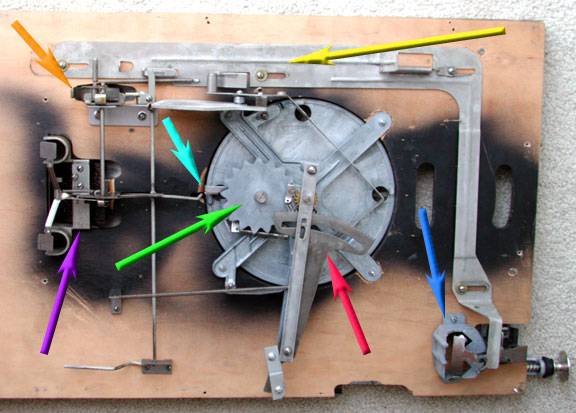
Internals
Rockola World Series has seven different mechanisms under the playfield.
- (yellow) reset when the coin is inserted ( and other anti- cheat devices)
- (dark blue) tilt mechanism that indicates excessive shaking of the game
- (red) winding mechanism that powers the turn table
- (light blue) the turn table itself, that rotates the runners around the baseball diamond
- (green) star wheel that makes the doubles, triples, and home runs happen
- (purple) the balls and strikes tilt table that keeps track of the count
- (orange) out counter that keeps track of how many outs and at three, prevents further play
Take a tour of the inside of the game.
Reset
The player approaches the game and puts a penny in the coin slide. As the player pushes in the coin slide, it in turn pushes the reset bar (yellow arrow at the top). This accomplishes several things all at the same time. Starting at the left of the head of the yellow arrow, it pushes balls representing runners out of the holes in the diamond. Next it resets the out count to zero, near the orange arrow at the far left. It resets the tilt indicator if it is showing a tilt from the previous game as shown by the extension of the reset bar that drops down to the bottom right.
As the player pushes in the ball lift rod, to load the first ball, the diamond or turn table is wound up. This happens as the push rod for the ball lift pushes against the bright metal lever, with two bumps, in the center bottom of the playfield. This pushes the rack, pointed to by the red arrow, to the right.
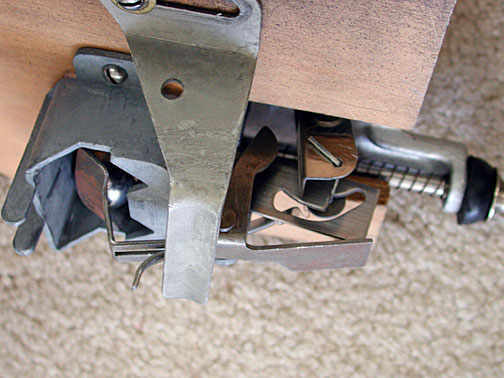
Tilt
The tilt mechanism is found at the bottom right of the playfield, pointed to by the dark blue arrow. It contains a large pinball and when agitated, the ball causes a window at the top of the playfield to show the word "TILTED" It normally shows three stars on a blue background.
The tilt mechanism is explained on a separate page.
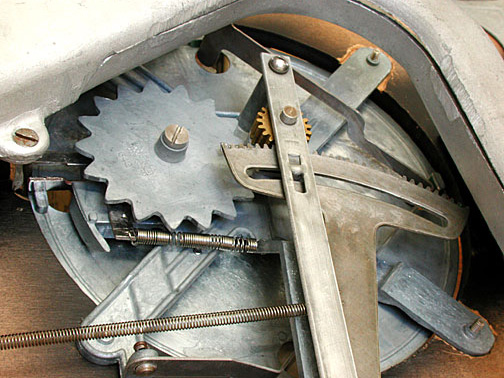
Winding Mechanism
Every time the player pushes the ball lift rod, the turn table is wound and ready to place the next runner on base. The red arrow in the top picture points to a winding rack that is tensioned with a spring exteding to the left. The rack teeth engage a ratched gear that is attached to the turn table. The ratchet allows the rack to move freely to the right. When the stop on the turn table is released, the rack pushes to the left, rotating the gear, and causing the turn table to rotate clockwise (in this view).
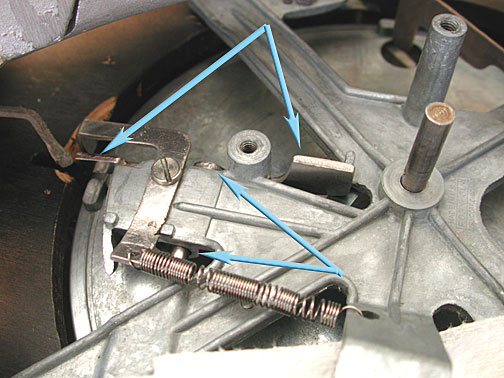
Turn Table
The turn table on a nicely restored game will gather significant momentum as it starts to rotate. The next lock will come along and hit the trip lever with force. Note the two blue arrows at the bottom, pointing to the pivot point of the locking lever. Note also the bottom pivot has a large area to the left in which to move. The trip lever is able to absorb the shock of the locking tab. The spring tensions a L bracket that keeps the trip lever from moving too far up in the picture, above the left top arrow. The L bracket pushes the trip lever back into position, ready for the next ball.
The turn table is ready to rotate and is awaiting a ball to roll down the center and enter the diamond. The weight of the ball pushes down a trip lever, pointed at in blue on the left, which releases the turn table. Note the oval raised metal lock or tab that is resting against the trip lever. As the lever raises (pushed down by the ball), the metal lock can rotate up and past the lever.
Note also the right portion of the trip lever, the right top blue arrow. This will become more important when the function of the star wheel, the fuction that provides doubles, triples, and home runs is described.
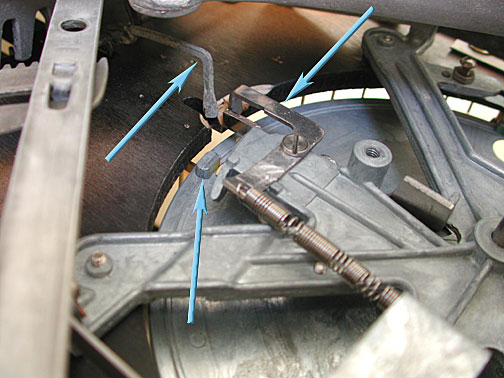
Here is another view, with the left arrow pointing to the anti-cheat blocking pin that prevents additional runners after the third out. The bottom arrow points to the locking tab. The top right arrow points to the shock absorbtion spring loaded, L lever.
